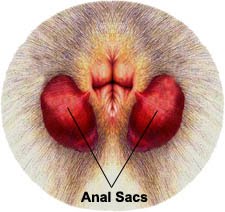Inevitably at least once during a typical clinical day, I’m asked to express a patient’s anal glands. More often than not, however, there is no real reason to do so. Perhaps perpetuated by the grooming industry or by incorrect information shared on the internet, many pet parents believe an animal’s anal glands should be routinely expressed by humans. This is false, and, indeed, may actually contribute to more serious anal gland issues in the future. This week I discuss the anal glands in more detail to provide some useful and shareworthy information. Happy reading!
Anal Glands – What are they?
There are two anal sacs (also known as anal glands) inside the anus of dogs and cats. They are located at the 4 o’clock and 8 o’clock positions if one pictures the face of a clock centered on the anus. The anal glands lie between the internal and external anal sphincters, the muscles that keep feces inside the rectum until a pet defecates. These sacs normally fill with a fetid substance that has a variable consistency. The fluid in anal glands can be thick and dark, clear and watery, and even chunky at times. All of these consistencies are normal. Currently the only discharge considered truly abnormal is one containing blood. Each sac is connected to the outside by a small tube (called a duct) that opens just inside the anus.

Animals have anal glands for both scent marking and self defense. Indeed, dogs and cats are smelling the anal glands when they sniff each other’s hind ends. The fluid also helps lubricate feces during defecation since the secretion is expressed onto the surface of the stool. Pet parents should know anal glands are routinely emptied of their secretions during normal defecation.

Anal Glands – When should I be worried?
Remember pets typically have no issues expressing their anal glands during routine defecation. However, some patients can’t empty them normally, resulting in impaction. Persistent scooting is, perhaps, the most common clinical sign observed in pets with impacted anal sacs. One incident of scooting is not necessarily an issue, but repeated scooting should prompt veterinary examination as soon as possible.
Other potential clinical signs include:
- Excessive licking the anus
- Difficulty defecating
- Abnormally formed feces
- Blood on the surface of feces and/or around the anus
- Vocalization during defecation
Routine expression of anal glands by people is not recommended. Rather it is best to let pets tell us if there is a problem first, typically through scooting behavior. Why? The tubes that connects each anal gland to the anus, (called ducts) as well as the resultant openings in the rectal wall (called puncta), are very narrow. The current theory is inappropriate and/or repeated expression of anal sacs creates meaningful inflammation in and around them. This inflammation subsequently obstructs the important ducts and/or puncti that can lead to chronic issues like a requirement for repeated human expression and formation of abscesses.
Scooting does not necessarily mean there is a problem with the anal glands. Other common causes of this behavior are skin allergies, food hypersensitivities, intestinal parasites (e.g.: cestodiasis or tapeworm infestation), and back pain (e.g.: lumbosacral disease).
Anal Gland Impaction – How is it treated?
Mildly impacted sacs may simply be treated by expressing them, emptying them of their fluid. For those patients with severely inflamed and impacts glands, sedation may be required to irrigate (flush) the sacs. A locally acting and/or systemic antibiotic, as well as appropriate pain medication, may be prescribed.
Overweight and obese animals tend to have recurrent issues because they are not able to empty their anal glands as efficiently as ideal weight animals. Therefore, pets should be kept in a proper body condition to help reduce the incidence of anal gland impaction. There is some evidence anal sac inflammation is exacerbated by envrionmental allergies and/or food hypersensitivities. Accordingly, partnering with a board-certified veterinary dermatologist may be uniquely helpful to identify an underlying issue that predisposes a patient to anal sac impaction.
With each impaction, there is a possibility of scarring that causes further narrowing of the anal ducts. Pets with recurrent anal gland impaction often benefit from surgical removal of these sacs. Removal of the anal sacs (called a sacculectomy) is a specialized surgery. Some primary veterinarians are comfortable performing the operation. Although rare, temporary and permanent nerve damage can happen, resulting in lack of bowel control. Thus, pet parents may be referred to a board-certified veterinary surgeon who has extensive training and experience performing this delicate procedure.
The takeaway message about anal gland impaction…
Anal glands are an animal’s proverbial calling card, providing other animals with distinct information. These sacs can become impacted, and the likelihood of problems with these structures increases with unwarranted expression of them. Animals with signs of potential anal sac troubles should be thoroughly evaluated by a veterinarian. Impacted anal glands can be expressed and/or flushed to empty them. Those patients with persistent anal sac impaction often benefit from surgical removal of them. Some family veterinarians are comfortable performing anal gland surgery. However due to the complex nature of this surgery, you may be referred to a board-certified veterinary surgeon.
To find a board-certified veterinary dermatologist, please visit the American College of Veterinary Dermatology.
To find a board-certified veterinary surgeon, please visit the American College of Veterinary Surgeons.
Wishing you wet-nosed kisses,
cgb




